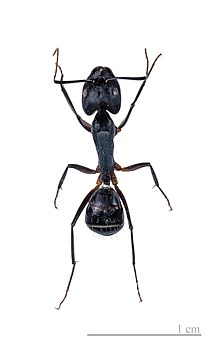Formicinae
| Formicinae Temporal range:
| |
|---|---|

| |
| Camponotus fellah | |
| Scientific classification | |
| Domain: | Eukaryota |
| Kingdom: | Animalia |
| Phylum: | Arthropoda |
| Class: | Insecta |
| Order: | Hymenoptera |
| Family: | Formicidae |
| Subfamily: | Formicinae Lepeletier, 1836 |
| Type genus | |
| Formica Linnaeus, 1758
| |
| Diversity | |
| 51 extant genera in 12 tribes | |
The Formicinae are a subfamily within the Formicidae containing ants of moderate evolutionary development.
Formicines retain some primitive features, such as the presence of
All members of the Formicinae "have a one-segmented petiole in the form of a vertical scale".[2]
Identification
Formicine ants have a single node-like or scale-like petiole (postpetiole entirely lacking) and the apex of the abdomen has a circular or U-shaped opening (the acidopore), usually fringed with hairs. A functional sting is absent, and defense is provided by the ejection of formic acid through the acidopore. If the acidopore is concealed by the pygidium and difficult to discern, then the antennal sockets are located well behind the posterior margin of the clypeus (cf. Dolichoderinae). In most formicines, the eyes are well developed (ocelli may also be present), the antennal insertions are not concealed by the frontal carinae, and the promesonotal suture is present and flexible.[3]
Tribes and genera
The tribal structure of the Formicinae is not completely understood. This list follows the scheme at AntCat,[4] but other schemes and names are used.
- Camponotini Forel, 1878
- Calomyrmex Emery, 1895
- CamponotusMayr, 1861 – carpenter ants (global)
- †Chimaeromyrma Dlussky, 1988
- Colobopsis Mayr, 1861[5]
- Dinomyrmex Ashmead, 1905
- Echinopla Smith, 1857
- Opisthopsis Dalla Torre, 1893
- Overbeckia Viehmeyer, 1916
- Polyrhachis Smith, 1857 (Asian, African tropics)
- †Pseudocamponotus Carpenter, 1930
- Formicini Latreille, 1809
- Alloformica Dlussky, 1969
- †Asymphylomyrmex Wheeler, 1915
- Bajcaridris Agosti, 1994
- Cataglyphis Foerster, 1850
- †Cataglyphoides Dlussky, 2008
- †Conoformica Dlussky, 2008
- Formica Linnaeus, 1758
- †Glaphyromyrmex Wheeler, 1915
- Iberoformica Tinaut, 1990
- Polyergus Latreille, 1804 – Amazon ants
- Proformica Ruzsky, 1902
- †Protoformica Dlussky, 1967
- Rossomyrmex Arnol'di, 1928
- Gesomyrmecini Ashmead, 1905
- Gesomyrmex Mayr, 1868
- †Prodimorphomyrmex Wheeler, 1915
- †Sicilomyrmex Wheeler, 1915
- GigantiopiniAshmead, 1905
- Gigantiops Roger, 1863 (Neotropical)
- Lasiini Ashmead, 1905
- Cladomyrma Wheeler, 1920
- Euprenolepis Emery, 1906
- Lasius Fabricius, 1804 – cornfield ants, citronella ants
- Metalasius Boudinot et al., 2022
- Myrmecocystus Wesmael, 1838 – honeypot ants
- Nylanderia Emery, 1906 – crazy ants
- Paraparatrechina Donisthorpe, 1947
- Paratrechina Motschoulsky, 1863
- Prenolepis Mayr, 1861 – false honey ants
- Pseudolasius Emery, 1887
- Zatania LaPolla et al., 2012
- Melophorini Forel, 1912
- Lasiophanes Emery, 1895
- Melophorus Lubbock, 1883 (Asutralian)
- Myrmecorhynchus André, 1896
- Notoncus Emery, 1895
- Notostigma Emery, 1920
- Prolasius Forel, 1892
- Pseudonotoncus Clark, 1934
- Stigmacros Forel, 1905
- Teratomyrmex McAreavey, 1957
- Myrmelachistini[5][6][7]
- Brachymyrmex Mayr, 1868
- Myrmelachista Roger, 1863
- MyrmoteratiniEmery, 1895
- Myrmoteras Forel, 1893
- OecophylliniEmery, 1895
- OecophyllaSmith, 1860 – weaver ants
- Plagiolepidini Forel, 1886
- Acropyga Roger, 1862
- Agraulomyrmex Prins, 1983
- Anoplolepis Santschi, 1914
- Aphomomyrmex Emery, 1899
- Bregmatomyrma Wheeler, 1929
- Lepisiota Santschi, 1926
- Petalomyrmex Snelling, 1979
- Plagiolepis Mayr, 1861
- Tapinolepis Emery, 1925
- SantschielliniForel, 1917
- Santschiella Forel, 1916
- incertae sedis
- †Attopsis Heer, 1850
- †Leucotaphus Donisthorpe, 1920
- †Liaoformica Hong, 2002
- †Longiformica Hong, 2002
- †Magnogasterites Hong, 2002
- †Orbicapitia Hong, 2002
- †Ovalicapito Hong, 2002
- †Ovaligastrula Hong, 2002
- †Protrechina Wilson, 1985
- †Sinoformica Hong, 2002
- †Sinotenuicapito Hong, 2002
- †WilsoniaHong, 2002
References
- PMID 11078527.
- ISBN 978-0-8014-7473-6.
- ^ "Subfamily: Formicinae". antweb.org. AntWeb. Retrieved 21 September 2013.
- ^ Bolton, B. (2013), "An online catalog of the ants of the world.", AntCat, retrieved 17 October 2023
- ^ PMID 27395929.
- ISSN 1070-9428.
- ^ "AntWeb". California Academy of Sciences. Retrieved 2018-03-10.
External links
 Media related to Formicinae at Wikimedia Commons
Media related to Formicinae at Wikimedia Commons Data related to Formicinae at Wikispecies
Data related to Formicinae at Wikispecies
